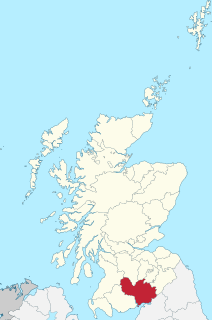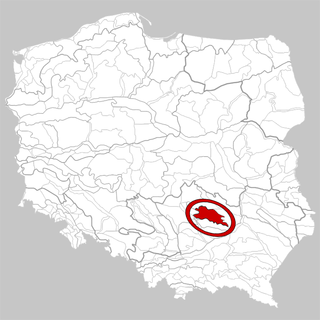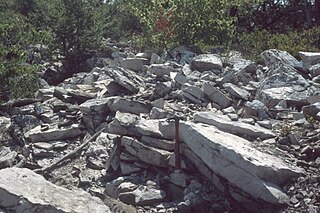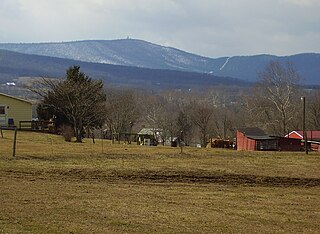The PaleozoicEra is the earliest of three geologic eras of the Phanerozoic Eon. It is the longest of the Phanerozoic eras, lasting from 541 to 251.902 million years ago, and is subdivided into six geologic periods : the Cambrian, Ordovician, Silurian, Devonian, Carboniferous, and Permian. The Paleozoic comes after the Neoproterozoic Era of the Proterozoic Eon and is followed by the Mesozoic Era.
The Silurian is a geologic period and system spanning 24.6 million years from the end of the Ordovician Period, at 443.8 million years ago (Mya), to the beginning of the Devonian Period, 419.2 Mya. The Silurian is the shortest period of the Paleozoic Era. As with other geologic periods, the rock beds that define the period's start and end are well identified, but the exact dates are uncertain by a few million years. The base of the Silurian is set at a series of major Ordovician–Silurian extinction events when up to 60% of marine genera were wiped out.

The Delaware Water Gap is a water gap on the border of the U.S. states of New Jersey and Pennsylvania where the Delaware River cuts through a large ridge of the Appalachian Mountains. The gap constitutes the southern portion of the Delaware Water Gap National Recreation Area, which is used primarily for recreational purposes, such as rafting, canoeing, swimming, fishing, hiking, and rock climbing.

Sir Roderick Impey Murchison, 1st Baronet, was a British geologist who first described and investigated the Silurian system.

The Lammermuirs are a range of hills in southern Scotland, forming a natural boundary between East Lothian and the Borders.

Dumfriesshire or the County of Dumfries is a historic county, registration county and lieutenancy area of Scotland.
Holy Cross or Saint Cross may refer to:

Mount of the Holy Cross is a high and prominent mountain summit in the northern Sawatch Range of the Rocky Mountains of North America. The 14,011-foot (4270.5 m) fourteener is located in the Holy Cross Wilderness of White River National Forest, 6.6 miles (10.7 km) west-southwest of the Town of Red Cliff in Eagle County, Colorado, United States. The summit of Mount of the Holy Cross is the highest point in Eagle County and the northern Sawatch Range.

The Świętokrzyskie Mountains, often anglicized to Holy Cross Mountains, are a mountain range in central Poland, near the city of Kielce. The Świętokrzyskie Mountains are some of the oldest mountains in Europe, and the highest between the Sudetes and the Ural Mountains.

The Mackenzie Mountains are a Canadian mountain range forming part of the Yukon-Northwest Territories boundary between the Liard and Peel rivers. The range is named in honour of Canada's second prime minister, Alexander Mackenzie. Nahanni National Park Reserve and Nááts'ihch'oh National Park Reserve are in the Mackenzie Mountains.

Mount Stromlo is a mountain with an elevation of 770 metres (2,530 ft) AHD that is situated in the Australian Capital Territory, Australia. The mountain is most notable as the location of the Mount Stromlo Observatory. The mountain forms part of the catchment area of the Cotter River which in turn is the primary water supply for part of ACT.

Newtontoppen is the largest and highest mountain in Svalbard, at 1,713 m. Its peak is the highest point on Svalbard. It is located at the north east corner on the island of Spitsbergen. The nearest settlement is the formerly Soviet coal mining settlement, Pyramiden.The mountain is mostly made of Silurian granite. The mountain was first ascended by Helge Backlund on 4 August 1900.

The Silurian Tuscarora Formation — also known as Tuscarora Sandstone or Tuscarora Quartzite — is a mapped bedrock unit in Pennsylvania, Maryland, West Virginia, and Virginia, USA.
Stone Mountain is a stratigraphic ridge in central Pennsylvania, United States, trending northwest of the Jacks Mountain ridge and Jacks Mountain Anticline. The ridge line separates Kishacoquillas Valley from the Seven Mountains area. Stone Mountain lies in, and the ridge line forms part of the border between, Mifflin and Huntingdon counties.

Cross Mountain is the highest peak in the Bear Pond Mountains, a sub range of the Appalachian Mountains. This grouping of mountains straddle the Maryland and Pennsylvania border.

The Bear Pond Mountains are a sub-range in the Appalachian Mountains, that straddle Pennsylvania and Maryland in the United States. These mountains are a part of the Ridge and Valley Appalachians and reach their highest point at Cross Mountain (Pennsylvania) 2,062 feet (628 m). A unique geologic feature known as the "Punchbowl" occurs in this range. This feature was created by the weathered shales of the Ordovician age in the center of a south-plunging anticline, having been eroded to expose a large amphitheater-like feature (punchbowl). Cross and Hearthstone Mountain are made of hard resistant quartzite of the Tuscarora Formation of the Silurian age, which form the walls of the bowl.

Pedoulas is a village in the Nicosia District of Cyprus, located at an altitude of 1,100 metres (3,600 ft) in the Troodos Mountains, 4 km south of Moutoullas. It lies in Marathasa Valley. The name is derived from the words pediada (valley) and laos (people). It is popular summer resort.

The Holy Cross Wilderness is a U.S. Wilderness Area located in San Isabel and White River national forests near Leadville, Minturn, Avon, Edwards, Eagle, and Vail, Colorado. The 122,797-acre (496.94 km2) wilderness with 164 miles (264 km) of trails was established in 1980. The wilderness was named after its highest peak, 14,005-foot (4,269 m) Mount of the Holy Cross.
Olev Vinn is Estonian paleobiologist and paleontologist.

Dunning Mountain is a stratigraphic ridge in central Pennsylvania, United States. The mountain's north end is at McKee Gap, which separates it from Short Mountain, and where Halter Creek flows westward towards the Frankstown Branch of the Juniata River. The south end of the mountain is contiguous with Evitts Mountain, but is marked by a sharp bend to the east. The valley formed by the bend is known as "The Kettle," and the broad valley to the east of Dunning Mountain is called Morrisons Cove. The town of Roaring Spring is located at the north end of the mountain on the east side.














